Pair drinks with “The Thin Man”, “King Kong”, and other pre-code greats in “Forbidden Cocktails”
EW exclusively shares recipes for cocktails to pair with "The Thin Man," "King Kong," "It Happened One Night," and "The Public Enemy."
There are few simple pleasures in life as satisfying as a cocktail perfectly paired with a classic film.
Forbidden Cocktails: Libations Inspired by the World of Pre-Code Hollywood, which hits shelves May 7, aims to bring readers 50 opportunities to do just that.
The book, by André Darlington, brings readers a collection of pre-Code films (a period of four years in the early 1930s when the production code existed but was not enforced) and dazzling drinks to accompany them. Darlington writes of how essential cocktails are to the movies of this era, the impact of Prohibition making booze a key element to the lively, taboo atmosphere of their settings.
EW has an exclusive first look at four drinks from the book — Tom Powers paired with The Public Enemy, King Kong paired with King Kong, It Happened One Morning paired with It Happened One Night, and Asta paired with The Thin Man. So, get out that cocktail shaker, perfect that two-step martini rhythm, and get drinking with the excerpts below.
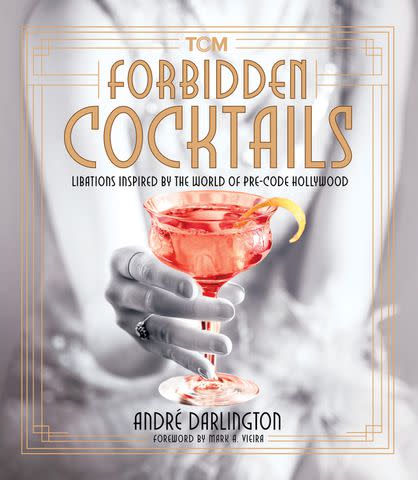
Courtesy of Running Press
'Forbidden Cocktails'The Public Enemy
Bursts of live machine-gun fire punctuate director William Wellman’s The Public Enemy (1931), a vicious gangster biography in which bootlegger Tom Powers (James Cagney) luxuriates in his ill-gotten gains: bespoke suits, custom cars, and Jean Harlow for a moll. Playing a character devoid of feeling save lust and vengefulness, Cagney is the ultimate villain-turned-hero, who, unlike Robinson’s Rico in Little Caesar (page 26), kills for the fun of it. If Rico is a fascinating creep audiences could not stop watching, Tom is a lovable sociopath with whom we identify: he was scarred by a brutal upbringing. Consequently driven to grab power, Tom is the American self-made everyman in a gangster bowler and overcoat.
Brutal and explosive, The Public Enemy shocked audiences. As the amoral Tom, James Cagney punches, kicks, and shoots his way to the top. There is the infamous scene in which he stuffs a grapefruit into the face of his girlfriend (Mae Clarke). In the next room, Edward Woods is in bed biting Joan Blondell’s earlobe. There is also Tom’s final moment in which he collapses and admits, “I ain’t so tough.” Despite romanticizing gangster life, or likely because of it, the film’s reception was overwhelmingly positive; a New York theater showed the film 24 hours a day. Cagney portrays a sadistic criminal, but he has courageously pulled himself out of the urban underclass.
The censors gave a big thumbs-down to the emerging “hard-boiled” realism in the film, passing it on the basis of its instructive value. The moviegoing public ensured that The Public Enemy’s box office outdid even Little Caesar. Real-life gangster Al Capone weighed in: “These gang pictures, that’s terrible kids’ stuff. They’re doing nothing but harm the younger element of the country. I don’t blame the censors for trying to bar them.” Rich.
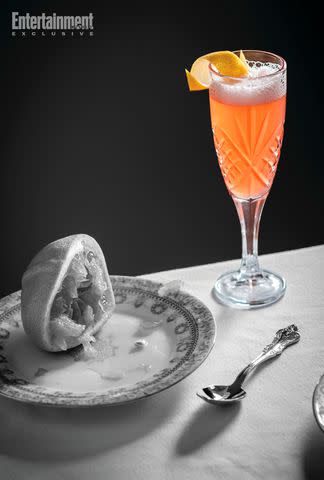
Steve Legato/Courtesy of Running Press
Tom Powers cocktailTom Powers
The ingredients in this cocktail pay homage to Powers's biography; he grew up in an Irish gang in Chicago, and we know he likes grapefruit for breakfast. This is a Chicago-style Prohibition drink that includes nods to Tom’s background as well as the tastes of gangsters like Capone.
1 ounce Irish whiskey
1/2 ounce fresh grapefruit juice
1/2 ounce Campari
1/4 ounce Luxardo maraschino liqueur
1 ounce sparkling wine
Lemon peel, for garnish
Shake whiskey, grapefruit juice, Campari, and maraschino liqueur with ice. Strain into a cocktail glass, top with sparkling wine, and garnish with a lemon peel.
King Kong
Few movies enraptured American audiences like King Kong (1933), maybe the most famous of all pre-code films. It is easy to see why, since the blockbuster embodies many of the era’s themes; it is a racial adventure film like Tarzan and His Mate, a nightmare like Frankenstein, and an interspecies love affair similar to Island of Lost Souls. Throw in one of cinema’s most relatable nonhuman stars and it was a recipe for box-office mania.
The ape appears as a coded figure in several early 1930s films, from Blonde Venus (see page 106) to The Sign of the Cross (see page 134), but none so prominently as Kong. He is a monstrous stand-in for audiences’ deep-seated fears of sexual violation—one that plays out before our very eyes between giant Kong and the small, white maiden Ann Darrow (Fay Wray). Never before had special effects worked so well in conjunction with sound technology to create a convincing narrative from what was, essentially, a kinky fever-dream. Filled with gore and sadism, the film flouted censorship while presenting a monster from another world smashing into the heart of civilization.
Kong is also a symbol of the financial and cultural chaos of the Depression. At the time of the film’s release, President Roosevelt had declared a holiday to stop a run on the banks and America was in crisis. Audiences felt the monster was close. It is no accident we witness Kong attacking the Sixth Avenue El right outside Manhattan’s Radio City theater, where the film played to packed houses.
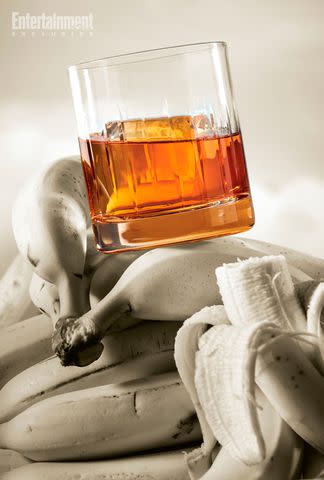
Steve Legato/Courtesy of Running Press
King Kong cocktailKing Kong
Inspired by a giant ape that climbs the Empire State Building, this unique cocktail combines whiskey, amaro, and banana liqueur for a kind of Banana Manhattan. The result is as outsized as Kong and a similarly formidable force with a playful side.
2 ounces bourbon whiskey
3/4 ounce amaro (such as Averna)
3/4 ounce banana liqueur
1 dash Angostura bitters
Stir bourbon, amaro, banana liqueur, and bitters with ice and strain into a rocks glass with a large ice cube.
It Happened One Night
One of the most famed and beloved of all pre-code movies, director Frank Capra’s It Happened One Night (1934) won every Academy Award for which it was nominated and is the first of three movies in history to win the “Big Five.” The film is a masterpiece, crackling with wit and positively oozing charm.
Spoiled heiress Ellen “Ellie” Andrews (Claudette Colbert) has married scheming cad King Westley (Jameson Thomas) against the wishes of her father (Walter Connolly), so her father has whisked her away on his yacht. Ellie escapes and finds herself penniless—as well as mostly useless in the real world—as she makes her way to New York City to be reunited with her beau. Along the way, she falls in with rapscallion reporter Peter Warne (Clark Gable) who offers to help reunite her with her husband in exchange for an exclusive story. Not to spoil things, but despite initial animosity, they fall for each other.
Adventure story, buddy flick, romance, and comedy all in one, Capra manages to weave several Depression-era subplots together to reveal the main characters’ worldviews. In fact, the film consistently addresses the country’s yawning class divide. Everything Ellie and Peter argue about is a result of their social stations, and by the end each has shared and revised their class perspectives. Of particular note is spoiled Ellie’s relationship to food. When we meet her, she is on a hunger strike because her father is keeping her from Westley. She even refuses a piece of steak—unthinkable in hungry 1934 America. However, after a few days on the road with Peter, Ellie learns to relish dunking a doughnut in black coffee.
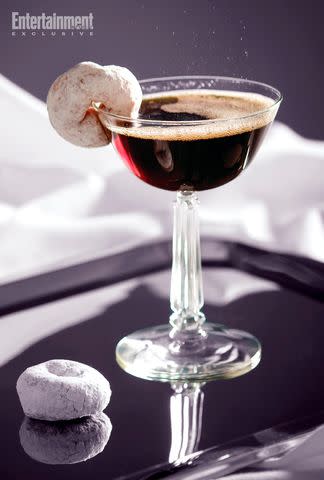
Steve Legato/Courtesy of Running Press
It Happened One MorningIt Happened One Morning
Dunking a doughnut in coffee is an important transformation in the film, indicating the moment when Ellie learns to enjoy the simple things in life. Re-create the scene with this coffee cocktail that is certain to wake you up on the right side of the bed. Add a fresh doughnut garnish, and it is a little bit of heaven.
11/2 ounces rye whiskey
1 ounce Kahlua
3/4 ounce espresso
1/4 ounce honey syrup (see recipe below)
Doughnut, for garnish
Shake whiskey, Kahlua, espresso, and honey syrup with ice. Strain into a cocktail glass and garnish with a doughnut.
The Thin Man
Prohibition, the so-called Noble Experiment, ended on December 5, 1933. The Thin Man, often hailed as the greatest of all cocktail-centric movies, released the following spring. The film features tipsy Nick Charles (William Powell) and his wife, Nora (Myrna Loy), a lovable couple who spend their days engaging in witty banter while sipping fancy drinks—when not chugging directly from the bottle. Written by noir maestro Dashiell Hammett of Maltese Falcon fame, The Thin Man is lighter than his normal fare and one of cinema’s most playful mysteries, thanks to the adaptation by husband-and-wife team Frances Goodrich and Albert Hackett.
Nick Charles is a retired private detective who has grown accustomed to a life of luxury, thanks to his wealthy wife, Nora, a high-society heiress. Inventor Clyde Wynant (Edward Ellis) disappears and is a prime suspect in the murder of his mistress, Julia (Natalie Moorhead). Wynant’s daughter, Dorothy (Maureen O’Sullivan), tries to enlist Nick to investigate, but he is reluctant to get involved, even though Nora craves some vicarious excitement. Charles relents when he realizes Police Lieutenant John Guild (Nat Pendleton) is coming to all the wrong conclusions. In order to resolve the case, Nick decides the best course of action is to invite all the suspects for dinner, making for a delightful grand finale.
A fast-paced romantic comedy brimming with chilled drinks and crackling dialogue, The Thin Man enamored audiences at the time, and the team of Powell and Loy went on to make five more Thin Man films together. What really hooked audiences was the astonishing rapport between Nick and Nora; their marriage works, and the two wisecrackers are true partners. Maybe cocktails are the secret to marital bliss, after all. The films were so popular, there is a style of cocktail glass named after the intrepid duo, the Nick & Nora.
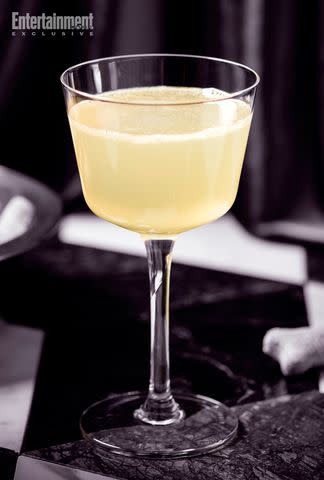
Steve Legato/Courtesy of Running Press
AstaAsta
With all the drinking in The Thin Man, a little hair of the dog will be necessary. This cocktail honors the Charleses' wire fox terrier, Asta. The famous pooch (his real name was Skippy) appeared in The Thin Man series but also in The Awful Truth (1937) and Bringing Up Baby (1938). The expression “hair of the dog” comes from a time when hair from a rabid dog applied to a wound was thought to cure its bite. While a hangover chaser can be pretty much anything, several period remedies include fresh ingredients such as lemon juice to revive the senses. Note that this cocktail is also perfect for holiday parties.
Absinthe, to rinse
1 ounce white rum
1/2 ounce Cointreau
1/2 ounce dry vermouth
3/4 ounce fresh lemon juice
1/4 ounce vanilla syrup (see RECIPE at bottom)
Rinse a Nick & Nora or cocktail glass with absinthe. Shake rum, Cointreau, dry vermouth, lemon juice, and vanilla syrup with ice and strain into the prepared glass.
For the Vanilla Syrup
1 cup water
1 cup granulated sugar
1 tablespoon vanilla extract
In a small saucepan over medium-high heat, heat the water until boiling. Remove from the heat. Add the sugar and vanilla and stir until combined. Transfer to a sealable jar and let cool. Syrup will keep in the refrigerator for up to 2 weeks.
For the Honey Syrup
1 cup water
1/2 cup honey
In a small saucepan over medium-high heat, heat water until just boiling and add honey. Remove from heat and stir until combined. Transfer to a sealable jar and let cool. Honey syrup will keep up to 2 weeks, sealed, in the refrigerator.
Excerpted from FORBIDDEN COCKTAILS: Libations Inspired by the World of Pre-Code Hollywood by André Darlington. Copyright ? 2024. Available from Running Press, an imprint of Hachette Book Group, Inc.
Related content:
Eddie Muller's Noir Bar reveals best drinks for classic films
Paul Feig's cocktail book features drinks inspired by Bridesmaids, Henry Golding, and more
Four party drinks to pair with The Tony Awards from I'll Drink to That cocktail book
Read the original article on Entertainment Weekly.
